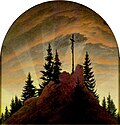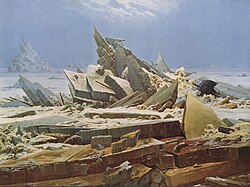Caspar David Friedrich

Caspar David Friedrich (September 5, 1774 – May 7, 1840) was a 19th-century German Romantic landscape painter.
He is best known for landscapes, which typically feature lonely figures against night skies, morning mists or Gothic ruins.
Caspar David Friedrich Media
Caspar David Friedrich, by Christian Gottlieb Kuhn (1807), Albertinum, Dresden
Cross in the Mountains (Tetschen Altar) (1808). 115 × 110.5 cm. Galerie Neue Meister, Dresden. Friedrich's first major work, the piece breaks with the traditional representation of crucifixion in altarpieces by depicting the scene as a landscape.
Chalk Cliffs on Rügen (1818). 90.5 × 71 cm. Museum Oskar Reinhart am Stadtgarten, Winterthur, Switzerland. Friedrich married Christiane Caroline Bommer in 1818, and on their honeymoon they visited relatives in Neubrandenburg and Greifswald. This painting celebrates the couple's union.[1]
Cemetery Entrance, Galerie Neue Meister, Dresden
The Abbey in the Oakwood (1808–1810). 110.4 × 171 cm. Alte Nationalgalerie, Berlin. Albert Boime writes, "Like a scene from a horror movie, it brings to bear on the subject all the Gothic clichés of the late eighteenth and early nineteenth centuries."[2]
The Sea of Ice (1823–1824), Kunsthalle Hamburg. This scene has been described as "a stunning composition of near and distant forms in an Arctic image".[3]
Related pages
- ↑ Vaughan 2004, p. 203.
- ↑ Boime 1990, p. 601.
- ↑ Larisey 1993, p. 14.








